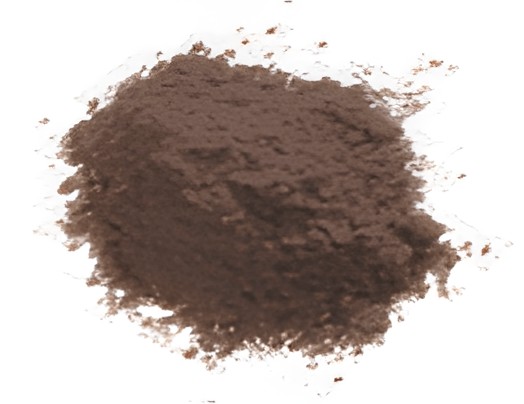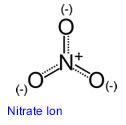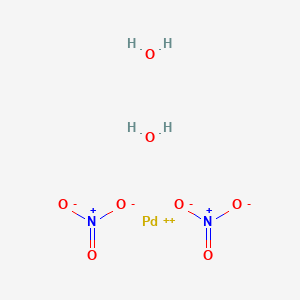SECTION 1. IDENTIFICATION
Product Name: Palladium(II) Nitrate Dihydrate
Product Number: All applicable American Elements product codes, e.g. PD-NAT-02-C.2HYD
, PD-NAT-03-C.2HYD
, PD-NAT-04-C.2HYD
, PD-NAT-05-C.2HYD
CAS #: 32916-07-7
Relevant identified uses of the substance: Scientific research and development
Supplier details:
American Elements
10884 Weyburn Ave.
Los Angeles, CA 90024
Tel: +1 310-208-0551
Fax: +1 310-208-0351
Emergency telephone number:
Domestic, North America: +1 800-424-9300
International: +1 703-527-3887
SECTION 2. HAZARDS IDENTIFICATION
Classification of the substance or mixture
Classification according to Regulation (EC) No 1272/2008
Oxidizing solids (Category 1), H271
Corrosive to Metals (Category 1), H290
Acute toxicity, Oral (Category 4), H302
Skin corrosion (Sub-category 1B), H314
Serious eye damage (Category 1), H318
Short-term (acute) aquatic hazard (Category 1), H400
Long-term (chronic) aquatic hazard (Category 1), H410
Label elements
Labelling according Regulation (EC) No 1272/2008
Signal word Danger
Hazard statement(s)
H271 May cause fire or explosion; strong oxidizer.
H290 May be corrosive to metals.
H302 Harmful if swallowed.
H314 Causes severe skin burns and eye damage.
H410 Very toxic to aquatic life with long lasting effects.
Precautionary statement(s)
P210 Keep away from heat.
P220 Keep/Store away from clothing/ combustible materials.
P221 Take any precaution to avoid mixing with combustibles.
P234 Keep only in original container.
P260 Do not breathe dust or mist.
P264 Wash skin thoroughly after handling.
P270 Do not eat, drink or smoke when using this product.
P273 Avoid release to the environment.
P280 Wear protective gloves/ protective clothing/ eye protection/ face
protection.
P283 Wear fire/ flame resistant/ retardant clothing.
P301 + P312 + P330 IF SWALLOWED: Call a POISON CENTER/doctor if you feel
unwell. Rinse mouth.
P301 + P330 + P331 IF SWALLOWED: Rinse mouth. Do NOT induce vomiting.
P303 + P361 + P353 IF ON SKIN (or hair): Take off immediately all contaminated
clothing. Rinse skin with water/shower.
P304 + P340 + P310 IF INHALED: Remove person to fresh air and keep comfortable
for breathing. Immediately call a POISON CENTER/doctor.
P305 + P351 + P338 +
P310
IF IN EYES: Rinse cautiously with water for several minutes.
Remove contact lenses, if present and easy to do. Continue
rinsing. Immediately call a POISON CENTER/doctor.
P306 + P360 IF ON CLOTHING: rinse immediately contaminated clothing and
skin with plenty of water before removing clothes.
P363 Wash contaminated clothing before reuse.
P370 + P378 In case of fire: Use dry sand, dry chemical or alcohol-resistant
foam to extinguish.
P371 + P380 + P375 In case of major fire and large quantities: Evacuate area. Fight
fire remotely due to the risk of explosion.
P390 Absorb spillage to prevent material damage.
P391 Collect spillage.
P405 Store locked up.
P406 Store in corrosive resistant container with a resistant inner
liner.
P501 Dispose of contents/ container to an approved waste disposal
plant.
Hazards not otherwise classified (HNOC) or not covered by GHS - none
SECTION 3. COMPOSITION/INFORMATION ON INGREDIENTS
Substances
Formula : N2O6Pd · xH2O
Molecular weight : 230.43 g/mol
CAS-No. : 32916-07-7
Component: Palladium(II) nitrate hydrate
Classification
Ox. Sol. 1; Met. Corr. 1;
Acute Tox. 4; Skin Corr.
1B; Eye Dam. 1; Aquatic
Acute 1; Aquatic Chronic
1; H271, H290, H302,
H314, H318, H400, H410
M-Factor - Aquatic Acute:
10
Concentration
<= 100 %
For the full text of the H-Statements mentioned in this Section, see Section 16.
SECTION 4. FIRST AID MEASURES
Description of first aid measures
General advice
Consult a physician. Show this safety data sheet to the doctor in attendance.Move out of
dangerous area.
If inhaled
If breathed in, move person into fresh air. If not breathing, give artificial respiration.
Consult a physician.
In case of skin contact
Take off contaminated clothing and shoes immediately. Wash off with soap and plenty of
water. Consult a physician.
In case of eye contact
Rinse thoroughly with plenty of water for at least 15 minutes and consult a
physician.Continue rinsing eyes during transport to hospital.
If swallowed
Do NOT induce vomiting. Never give anything by mouth to an unconscious person. Rinse
mouth with water. Consult a physician.
Most important symptoms and effects, both acute and delayed
The most important known symptoms and effects are described in the labelling (see section
2.2) and/or in section 11
Indication of any immediate medical attention and special treatment needed
No data available
SECTION 5. FIREFIGHTING MEASURES
Extinguishing media
Suitable extinguishing media
Dry powder Dry sand
Special hazards arising from the substance or mixture
Nitrogen oxides (NOx)
Advice for firefighters
Wear self-contained breathing apparatus for firefighting if necessary.
Further information
Use water spray to cool unopened containers.
SECTION 6. ACCIDENTAL RELEASE MEASURES
Personal precautions, protective equipment and emergency procedures
Wear respiratory protection. Avoid dust formation. Avoid breathing vapours, mist or gas.
Ensure adequate ventilation. Evacuate personnel to safe areas. Avoid breathing dust.
For personal protection see section 8.
Environmental precautions
Prevent further leakage or spillage if safe to do so. Do not let product enter drains.
Discharge into the environment must be avoided.
Methods and materials for containment and cleaning up
Sweep up and shovel. Contain spillage, and then collect with an electrically protected
vacuum cleaner or by wet-brushing and place in container for disposal according to local
regulations (see section 13). Keep in suitable, closed containers for disposal.
Reference to other sections
For disposal see section 13.
SECTION 7. HANDLING AND STORAGE
Precautions for safe handling
Avoid contact with skin and eyes. Avoid formation of dust and aerosols.Further processing
of solid materials may result in the formation of combustible dusts. The potential for
combustible dust formation should be taken into consideration before additional processing
occurs.
Provide appropriate exhaust ventilation at places where dust is formed.Keep away from
sources of ignition - No smoking.
For precautions see section 2.2.
Conditions for safe storage, including any incompatibilities
Keep container tightly closed in a dry and well-ventilated place.
Light sensitive. hygroscopic Keep in a dry place.
Storage class (TRGS 510): 5.1A: Strongly oxidizing hazardous materials
Specific end use(s)
Apart from the uses mentioned in section 1.2 no other specific uses are stipulated
SECTION 8. EXPOSURE CONTROLS/PERSONAL PROTECTION
Control parameters
Components with workplace control parameters
Contains no substances with occupational exposure limit values.
Exposure controls
Appropriate engineering controls
Handle in accordance with good industrial hygiene and safety practice. Wash hands
before breaks and at the end of workday.
Personal protective equipment
Eye/face protection
Face shield and safety glasses Use equipment for eye protection tested and
approved under appropriate government standards such as NIOSH (US) or EN
166(EU).
Skin protection
Handle with gloves. Gloves must be inspected prior to use. Use proper glove
removal technique (without touching glove's outer surface) to avoid skin contact
with this product. Dispose of contaminated gloves after use in accordance with
applicable laws and good laboratory practices. Wash and dry hands.
Full contact
Material: Nitrile rubber
Minimum layer thickness: 0.11 mm
Break through time: 480 min
Material tested:Dermatril® (KCL 740 / Aldrich Z677272, Size M)
Splash contact
Material: Nitrile rubber
Minimum layer thickness: 0.11 mm
Break through time: 480 min
Material tested:Dermatril® (KCL 740 / Aldrich Z677272, Size M)
data source: KCL GmbH, D-36124 Eichenzell, phone +49 (0)6659 87300, e-mail
sales@kcl.de, test method: EN374
If used in solution, or mixed with other substances, and under conditions which
differ from EN 374, contact the supplier of the CE approved gloves. This
recommendation is advisory only and must be evaluated by an industrial hygienist
and safety officer familiar with the specific situation of anticipated use by our
customers. It should not be construed as offering an approval for any specific use
scenario.
Body Protection
Complete suit protecting against chemicals, The type of protective equipment must
be selected according to the concentration and amount of the dangerous substance
at the specific workplace.
Respiratory protection
Where risk assessment shows air-purifying respirators are appropriate use a fullface
particle respirator type N100 (US) or type P3 (EN 143) respirator cartridges as
a backup to engineering controls. If the respirator is the sole means of protection,
use a full-face supplied air respirator. Use respirators and components tested and
approved under appropriate government standards such as NIOSH (US) or CEN
(EU).
Control of environmental exposure
Prevent further leakage or spillage if safe to do so. Do not let product enter drains.
Discharge into the environment must be avoided.
SECTION 9. PHYSICAL AND CHEMICAL PROPERTIES
Information on basic physical and chemical properties
a) Appearance Form: powder
Colour: brown
b) Odour No data available
c) Odour Threshold No data available
d) pH No data available
e) Melting
point/freezing point
No data available
f) Initial boiling point
and boiling range
No data available
g) Flash point ()No data available
h) Evaporation rate No data available
i) Flammability (solid,
gas)
No data available
j) Upper/lower
flammability or
explosive limits
No data available
k) Vapour pressure No data available
l) Vapour density No data available
m) Relative density No data available
n) Water solubility No data available
o) Partition coefficient:
n-octanol/water
No data available
p) Auto-ignition
temperature
No data available
q) Decomposition
temperature
No data available
r) Viscosity No data available
s) Explosive properties No data available
t) Oxidizing properties May cause fire or explosion; strong oxidizer.
9.2 Other safety information
No data available
SECTION 10. STABILITY AND REACTIVITY
Reactivity
No data available
Chemical stability
Stable under recommended storage conditions.
Possibility of hazardous reactions
No data available
Conditions to avoid
No data available
Incompatible materials
Strong reducing agents, Strong acids
SECTION 11. TOXICOLOGICAL INFORMATION
Information on toxicological effects
Acute toxicity
LD50 Oral - Rat - male and female - 200 - 2,000 mg/kg
(OECD Test Guideline 423)
Inhalation: No data available
Dermal: No data available
No data available
Skin corrosion/irritation
Skin - in vitro assay
Result: Corrosive
(OECD Test Guideline 435)
Serious eye damage/eye irritation
No data available
Respiratory or skin sensitisation
No data available
Germ cell mutagenicity
No data available
Carcinogenicity
IARC: No component of this product present at levels greater than or equal to 0.1% is
identified as probable, possible or confirmed human carcinogen by IARC.
NTP: No component of this product present at levels greater than or equal to 0.1% is
identified as a known or anticipated carcinogen by NTP.
OSHA: No component of this product present at levels greater than or equal to 0.1% is
on OSHA’s list of regulated carcinogens.
Reproductive toxicity
No data available
Specific target organ toxicity - single exposure
No data available
Specific target organ toxicity - repeated exposure
No data available
Aspiration hazard
No data available
Additional Information
RTECS: Not available
To the best of our knowledge, the chemical, physical, and toxicological properties have not
been thoroughly investigated.
Stomach - Irregularities - Based on Human Evidence
SECTION 12. ECOLOGICAL INFORMATION
Toxicity
No data available
Toxicity to algae static test EC50 - Desmodesmus subspicatus (green algae) - 0.063
mg/l - 72 h
(OECD Test Guideline 201)
Persistence and degradability
No data available
Bioaccumulative potential
No data available
Mobility in soil
No data available
Results of PBT and vPvB assessment
PBT/vPvB assessment not available as chemical safety assessment not required/not
conducted
Other adverse effects
An environmental hazard cannot be excluded in the event of unprofessional handling or
disposal.
Very toxic to aquatic life with long lasting effects.
No data available
SECTION 13. DISPOSAL CONSIDERATIONS
Waste treatment methods
Product
Offer surplus and non-recyclable solutions to a licensed disposal company. Burn in a
chemical incinerator equipped with an afterburner and scrubber but exert extra care in
igniting as this material is highly flammable. Contact a licensed professional waste
disposal service to dispose of this material.
Contaminated packaging
Dispose of as unused product.
SECTION 14. TRANSPORT INFORMATION
DOT (US)
UN number: 1477 Class: 5.1 Packing group: II
Proper shipping name: Nitrates, inorganic, n.o.s.
Reportable Quantity (RQ):
Poison Inhalation Hazard: No
IMDG
UN number: 1477 Class: 5.1 Packing group: II EMS-No: F-A, S-Q
Proper shipping name: NITRATES, INORGANIC, N.O.S.
IATA
UN number: 1477 Class: 5.1 Packing group: II
Proper shipping name: Nitrates, inorganic, n.o.s.
SECTION 15. REGULATORY INFORMATION
SARA 302 Components
This material does not contain any components with a section 302 EHS TPQ.
SARA 313 Components
This material does not contain any chemical components with known CAS numbers that
exceed the threshold (De Minimis) reporting levels established by SARA Title III, Section
313.
SARA 311/312 Hazards
Reactivity Hazard, Acute Health Hazard, Chronic Health Hazard
Massachusetts Right To Know Components
No components are subject to the Massachusetts Right to Know Act.
SECTION 16. OTHER INFORMATION
Safety Data Sheet according to Regulation (EC) No. 1907/2006 (REACH). The above information is believed to be correct but does not purport to be all inclusive and shall be used only as a guide. The information in this document is based on the present state of our knowledge and is applicable to the product with regard to appropriate safety precautions. It does not represent any guarantee of the properties of the product. American Elements shall not be held liable for any damage resulting from handling or from contact with the above product. See reverse side of invoice or packing slip for additional terms and conditions of sale. COPYRIGHT 1997-2022 AMERICAN ELEMENTS. LICENSED GRANTED TO MAKE UNLIMITED PAPER COPIES FOR INTERNAL USE ONLY.


 See more Palladium products.
See more Palladium products. Palladium has the lowest melting point and is the least dense of the group. Palladium can be found as a free metal and alloyed with other platinum-group metals.
Palladium has the lowest melting point and is the least dense of the group. Palladium can be found as a free metal and alloyed with other platinum-group metals. 
